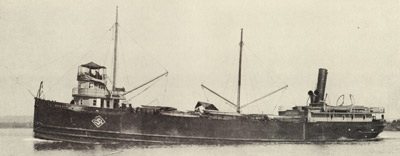Table of Contents
In the late 1880's, Polson Iron Works Ltd. of Toronto established a branch shipyard at the Georgian Bay port of Owen Sound, Ontario. The first vessel built at the new yard was the famous passenger and package freight steamer MANITOBA launched in 1889 for the Canadian Pacific Railway as a replacement for the unfortunate ALGOMA. In fact, the engines of ALGOMA were salvaged from the wreck on Isle Royale and fitted in MANITOBA where they served until the steamer was scrapped in 1950.
The second vessel built by Polsons at Owen Sound was the freight steamer SEGUIN (Can. 94763). She was 207.0 feet in length, 34.2 feet in the beam, and 13.0 feet in depth, and her tonnage was 1141 Gross, 771 Net. Launched in 1890, she was an iron and steel bulk carrier constructed primarily to carry lumber, her owners being the Parry Sound Transportation Company Ltd., Toronto. This concern was controlled by lumberman J. B. Miller.

The camera of A. E. Young caught SEGUIN upbound in the St. Mary's River about 1918. Photo from the Bascom collection.
SEGUIN was powered by a triple expansion engine built by Polsons in 1890 with cylinders measuring 17", 28" and 46" and a 30" stroke. This machinery gave her Nominal Horsepower of 116 on steam supplied by two Scotch boilers measuring 11' by 11'. It is interesting to note that these engines outlived the hull for which they were built. Subsequent to the final demise of SEGUIN, over a half century later, they were installed in the big tug STOIC ESSEX for the Detroit and Walkerville Perry Company. She was later known as the tug (b) J. E. McQUEEN before being purchased by the Imperial Oil Company Ltd. in 1944 and rebuilt and repowered for use in South American waters.
SEGUIN served in the lumber trade and other operations for the Parry Sound Transportation Company Ltd. until 1916 when she was purchased by A. B. McKay of Hamilton. He sold her in 1917 to Canada Steamship Lines Ltd., Montreal, who rebuilt her as a package freighter with 'tween decks. To facilitate the handling of package freight, two deck cranes were fitted soon after the conversion. They replaced SEGUIN's main mast and the cargo booms which were fitted on it. In fact, at the time of her commissioning in 1890, SEGUIN had carried three masts and was equipped for auxiliary sail.
C.S.L. introduced its "Maple" series of names (see the October "Ship of the Month") in 1919 and accordingly in 1920 SEGUIN became (b) MAPLEBORO, the "B" of "Boro" signifying that the ship was a package freighter. During the 1920's, C.S.L. departed from its usual colour scheme when MAPLEBORO served as an additional ship on the Northern Navigation Company Division package freight run from Sarnia to the Lakehead. Presumably to make her look more like the large passenger steamers on the same route, she was given a black hull with a wide white band extending down from the deck for about six feet. She was the only freight vessel to be so painted and looked all the more unusual in that she had no raised forecastle -- in fact, the "forecastle" was actually a step or two below the rest of the deck.
In 1923, MAPLEBORO was placed on the Montreal-Toronto-Hamilton express package freight service and to conform with the practice of having vessels on this route named for the cities they served, she was renamed (c) CITY OF MONTREAL (II). She did not see much service on this route, however, for in 1926 there arrived the first of the new "City" class express steamers built especially for the service. She was accordingly given the name (d) ARVIDA but continued on the run until the next year when all of the new vessels were in operation.
ARVIDA was laid up in Hamilton in 1927 and after several years of inactivity she was towed to Kingston where she joined Canada Steamship Lines' large fleet of inactive carriers, many of which were never again to see active service. She remained at Kingston until 1937 when she was sold to Les Chantiers Manseau Ltee., Sorel, the firm that later became known as Marine Industries Ltd. The by now decrepit remains of ARVIDA were towed to Sorel and there, in 1944, she was cut up for scrap.
Previous Next
Return to Home Port or Toronto Marine Historical Society's Scanner
Reproduced for the Web with the permission of the Toronto Marine Historical Society.